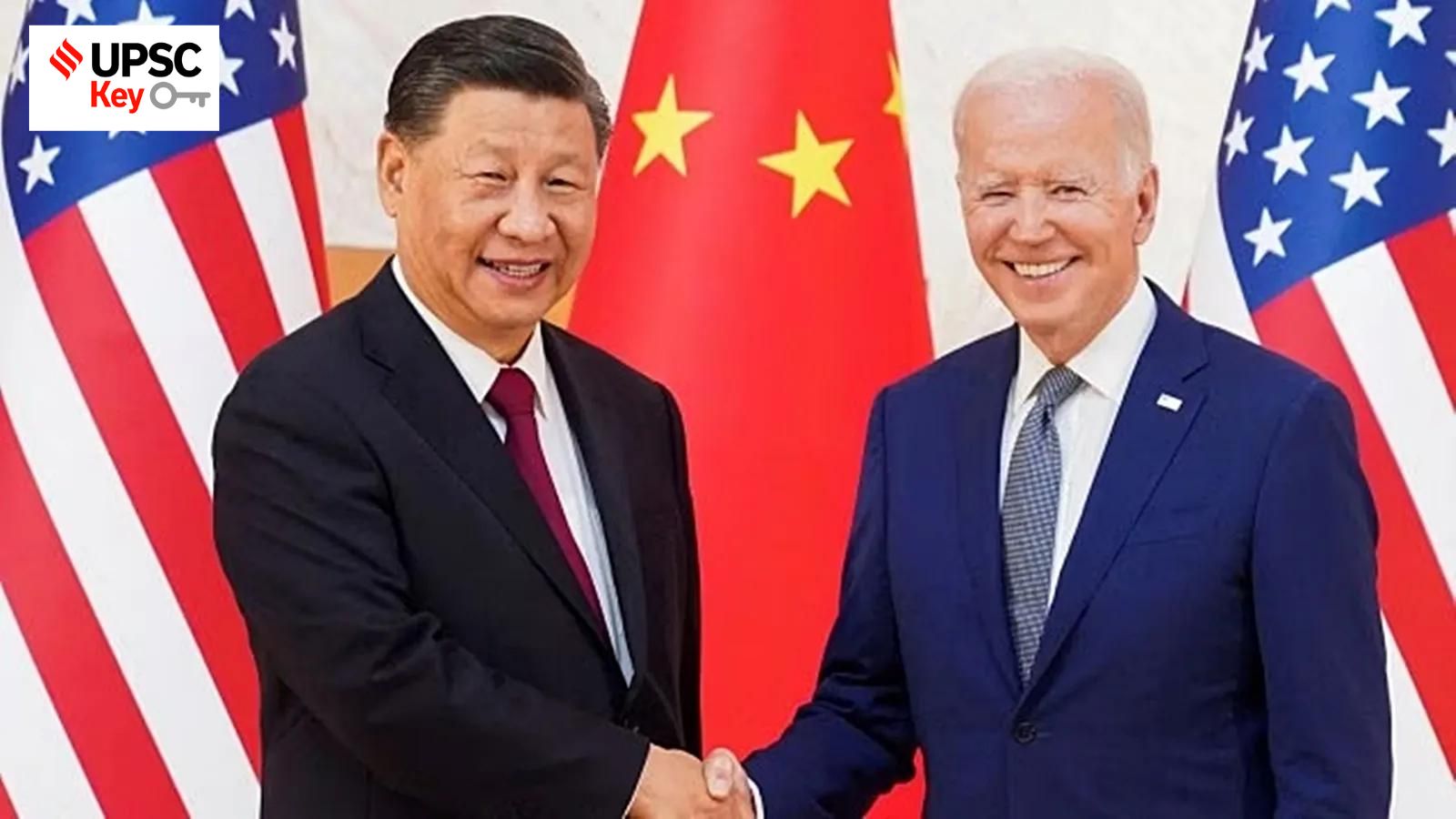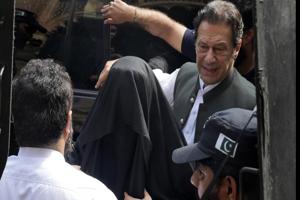
Prerequisites:—Temperature and soil condition for lavender cultivation— Lavender cultivation in India— What is floriculture? Facts about lavender— Lavender, which can be grown in areas that experience snowfall and have a hilly terrain, blossoms and is ready for harvesting two-and-a-half years after it is planted. This is despite various policies of the government and a plethora of decisions discussing the adverse effects of climate change. Prerequisites:— What did SC say on Right against adverse effects of climate change part of rights to life, equality? Post Read Questions:— In the era of climate change, a centre-heavy devolution of legislative power is not tenable.
Important topics and their relevance in UPSC CSE exam for April 10, 2024. If you missed the April 9, 2024 UPSC CSE exam key from the Indian Express, read it here.
Strategic military infra upgrade in the works for Andaman & Nicobar
UPSC Syllabus
Preliminary Examination: Current events of national and international importance.
Mains Examination: GS III – Security Issues
What’s the ongoing story– With revamped airfields and jetties to additional logistics and storage facilities, habitat for troops to a robust surveillance infrastructure, the strategic Andaman and Nicobar Islands are in the middle of a major military infrastructure upgrade, senior officials familiar with the developments have told The Indian Express.
Prerequisites:
— What is the Naval Communication Network (NCN)?
Advertisement
Map Work: Myanmar’s Coco Islands, South China Sea (islands and countries in news) and Strait of Malacca.
Key takeaways:
— The enhanced infrastructure is aimed to facilitate deployment of additional military forces, and facilities for larger and more warships, aircraft, missile batteries and troops.
— The ongoing large-scale construction activities come amid growing Chinese attempts to expand its influence in the region, which includes the construction of a military facility at Myanmar’s Coco Islands lying 55 km north of A&N Islands.
— There are 836 Islands in A&N, of which only 38 are inhabited.
Advertisement
— Sources said there are plans to significantly enhance the surveillance infrastructure at one of the northern islands of A&N, and to construct a permanent habitat for troops there.
— Centre is learnt to have asked the National Remote Sensing Centre (NRSC) to increase its manpower to analyse satellite imagery, technical capacity of NRSC analysis and dissemination of analysed data to enhance surveillance of 55 inhabited islands in Andaman and Nicobar Islands and Lakshadweep.
For Your Information:
— Importance of the chain of islands: The Andaman and Nicobar Islands are of great strategic importance since they straddle one of the busiest sea lanes in the world and give India the reach to monitor the flow of traffic from the South China Sea (Pacific Ocean) to the Andaman Sea (Indian Ocean) via the Strait of Malacca that’s key to trade and oil shipments in the Indo-Pacific.
Point to ponder:
— The Andaman and Nicobar islands offer a springboard from where Delhi can project power, exert influence, strike friendships in its eastern neighbourhood. Discuss.
Post Read Question:
Advertisement
—The Andaman and Nicobar Command (ANC) is the first and only tri-service command in the islands and was established in 2001. (True/False)
— The Armed Forces are planning to turn Andaman and Nicobar into the first “tri-service common defence station” in the country. (True/False)
—What is the role of the National Remote Sensing Centre (NRSC)?
Other Important Article Covering the same topic:
The maritime ‘Great Game’: Why Delhi needs to bolster the Andaman and Nicobar Command
Advertisement
India has 2nd highest hepatitis cases, 11 percent of global burden
UPSC Syllabus
Preliminary Examination: Current events of national and international importance.
Mains Examination: GS II: Issues relating to development and management of Social Sector/Services relating to Health, Education, Human Resources.
What’s the ongoing story– India is one of the countries with the highest burden of viral hepatitis — an infection that causes liver inflammation, damage and may lead to liver cancer — with 2.9 crore people living with Hepatitis B infection and 0.55 crore living with Hepatitis C infection, according to the Global Hepatitis Report 2024 released by the World Health Organisation (WHO) on Tuesday.
Prerequisites:
— What is the Universal Immunisation Programme in India?
Key takeaways:
— There were over 50,000 new Hepatitis B cases and 1.4 lakh new Hepatitis C cases reported in 2022. And these infections killed 1.23 lakh people in India in 2022 as per the report.
Advertisement
—Both infections are transmitted from mother to child during delivery, during transfusion of blood that hasn’t been screened properly, during contact with the blood of an infected person or while sharing needles by drug users. Since hepatitis B can be prevented through vaccination, the report highlights the need to ensure coverage. Hepatitis C is curable with medicines.
—Hepatitis B is known to cause acute infection with nausea, vomitting and yellowing of the eye and skin for several weeks. Liver failure happens in severe cases. But the challenge is the chronic, life-long liver disease that it causes, especially when children get it.
— The chronic infection can lead to scarring of the liver called cirrhosis and increase the risk of liver cancer. There are medicines to slow the progress of the virus in chronic cases.
—Many people with the hepatitis C virus don’t have symptoms or know they are infected. Those who do develop symptoms two to 12 weeks after exposure report yellow skin or eyes, loss of appetite, nausea, stomach ache, fever, dark urine, light-coloured stool, joint pain and exhaustion.
Post Read Question:
Advertisement
— Hepatitis B vaccine is offered to children under the Universal Immunisation Programme in India. (True/ False)
— Which of the following statements is not correct? (UPSC CSE 2015)
(a) Hepatitis B virus is transmitted much like HIV.
(b) Hepatitis B, unlike Hepatitis C, does not have a vaccine.
(c) Globally, the number of people infected with Hepatitis B and C viruses are several times more than those infected with HIV.
Advertisement
(d) Some of those infected with Hepatitis B and C viruses do not show the symptoms for many years.
EXPRESS NETWORK
Trains to ply at 40 kmph at night to save lions from collision deaths
Syllabus:
Preliminary Examination: Current events of national importance, Indian Geography
Mains Examination: GS I and GS III: Distribution of key natural resources, Conservation of species.
What’s the ongoing story- The Railways and Gujarat forest department told the High Court that they have framed a revised standard operating protocol (SOP), limiting train speed to less than 40 km per hour on the busy Pipavav-Surendranagar rail line during night to avoid collision with lions in Amreli district.
Advertisement
— A joint meeting of forest and railway officials was held after the HC took note of three lion deaths in January, two of them dying from train accidents.
Prerequisites:
— Location of Gir Wildlife division
— IUCN status of Lion
Key takeaways:
— The Pipava-Surendranagar railway track of PRCL is lifeline of Pipavav port on Rajula coast of Amreli.
— The areas that record a frequency of lion movements as lion hotspots and the Railways agreed to restrict the speed of trains to below 40 kmph during night to avoid collision with lions.
— The speed restriction will eliminate chances of train-lion collision by 60 to 70 per cent.
— The train speed is restricted to 20 kmph on Visavadar-Talala section in Gir (west) wildlife division in Junagadh and Gir Somnath districts and no train operations are allowed during night.
For Your Information:
— Seven lions had died on being hit by trains between July 2023 and January 2024 on the Pipavav-Surendranagar section.
— The HC, in its order, recorded that “when these accidents occurred in January 2024, the appropriate course of action of the forest and railway officials was to make an inquiry jointly or separately to ascertain the cause of death on the railway track and take corrective measures, which ought to have been done at their own ends without intervention” from the court.
Points to Ponder:
— Shetrunji river floodplains
— Highest population of Lions in which state?
— Purna Wildlife Sanctuary
Post Read Question:
— Pipavav-Surendranagar rail line was recently in news due to a collision of lions with train. It is located in:
(a) Maharashtra
(b) Gujarat
(c) Rajasthan
(d) Madhya Pradesh
Other Important Article Covering the same topic:
Cat scan in Gujarat: Walking the extra mile to keep Asiatic lions safe
Asiatic lions population rising, new sanctuary proposed in Saurashtra
Lavender cultivation turns farmers into big businessmen in J&K’s Doda
Syllabus:
Preliminary Examination: Environmental Ecology, Biodiversity
Mains Examination: Major crops-cropping patterns in various parts of the country, transport and marketing of agricultural produce and issues and related constraints.
What’s the ongoing story- When lavender cultivation was first introduced to Bhaderwah subdivision in Jammu and Kashmir’s Doda district in 2015, most farmers were sceptical and just a handful gave it a go. Today, these early adopters have significantly expanded cultivation, employ 30-40 people each on a full-time basis, have their own distillation units for making lavender oil, and market their products in different parts of the country.
Prerequisites:
—Temperature and soil condition for lavender cultivation
— Lavender cultivation in India
— What is floriculture?
Key takeaways:
— According to officials, more than 700 acres of farmland has been brought under lavender cultivation in the area since 2017, and another 100 acres is set to be added.
— The crop was officially introduced in Bhaderwah by the Council Of Scientific and Industrial Research-Indian Institute of Integrative Medicine (CSIR-IIIM), Jammu, in 2015.
— CSIR plans to distribute lavender plants to farmers in parts of Kathua, Rajouri, Poonch, and the Kashmir Valley, besides Uttrakhand, Himachal Pradesh and the Northeast.
— CSIR-IIIM, Jammu, provides lavender growers end-to-end support, from supplying them quality planting material, to training them, helping them with distillation, and providing them market linkages.
— There is a sharp decline in the price of lavender oil, now around Rs 2,500-3,000 per litre as opposed to Rs 12,000 a few years ago. The price drop has been attributed to the import of oil from Bulgaria, France and China by buyers elsewhere in India.
For Your Information:
— The CSIR-Aroma Mission is a flagship project of CSIR under which Lavender cultivation is being promoted in the temperate regions of J&K.The aim of the project is to increase the income of small and marginal farmers and develop agriculture-based Startups.
Facts about lavender
— Lavender, which can be grown in areas that experience snowfall and have a hilly terrain, blossoms and is ready for harvesting two-and-a-half years after it is planted.
— The same plant can bear flowers for 18-20 years, and does not require the amount of insecticides, pesticides, and other chemicals used on conventional crops like maize and paddy.
— The uses of lavender includes manufacturing perfumes, soaps, agarbatti, and room fresheners.
— The variety of Lavender is highly suitable for cultivation in the rainfed temperate regions of India.
— The benefit of selling dried flowers is that the buyer knows there is no adulteration, and apart from extracting oil from it as per requirement, the buyer can also use it for other products.
Points to Ponder:
— Varieties of lavender
— Aroma Mission
— Purple revolution
Post Read Question:
— With reference to the lavender cultivation in India, consider the following statements:
It is highly suitable for cultivation in the dry regions of India. Arunachal Pradesh leads in the production of lavender. It is used for manufacturing perfumes.
How many of the statements given above are correct?
(a) Only one
(b) Only two
(c) All three
(d) None
Other Important Article Covering the same topic:
After ‘purple revolution’, CSIR scientists focus on medicinal properties of lavender
THE IDEAS PAGE
An Elusive grand bargain
UPSC Syllabus
Preliminary Examination: Current events of national and international importance.
Mains Examination: Bilateral, regional and global groupings and agreements involving India and/or affecting India’s interests.
What’s the ongoing story– C Raja Mohan writes: When the Joe Biden administration described its China strategy as “responsible competition”, many analysts in India and beyond dismissed it as mission impossible. The administration insisted that it would cooperate with China where possible and challenge it where it must. President Biden also affirmed that he would do the utmost to prevent the vigorous competition with China from becoming a dangerous conflict. This, in turn, has involved an element of sustained high-level engagement.
For many in the Indian strategic community, maintaining a balance between competition and cooperation is unsustainable. They worry that the engagement track will prevail at the expense of America’s friends and partners and in favour of Beijing.
The Central Question: As the world’s largest economies with massive interdependence and as leading military powers, the US and China’s imperatives to engage are real. So are the contradictions between Washington and Beijing. What are these engagements and contradictions and how does it impact India and China’s other neighbours?
Prerequisites:
—What is the South China Sea dispute?
—What is the relevance of the San Francisco summit of the Asia Pacific Economic Cooperation forum?
—What are AUKUS and Quad?
Key takeaways:
US engagement with China :
—As a power far away from Asia and facing no direct threats from China, there will always be reasons for the US to find an accommodation with China.
—The growing sense of economic threat from China and the prospect that Beijing is trying to nudge America out of Asia has brought Washington together on the idea of pushing back. This is one of the few things that Democrats and Republicans agree on — the difference is on how hard to push back.
—Several current developments involving the US and China give us a sense of this strategy (Biden’s “responsible competition” with China)
— Last week, we saw a long telephone call between Biden and the Chinese leader Xi Jinping.
— President Xi visited the US to attend the San Francisco summit of the Asia Pacific Economic Cooperation forum last November when the two sides announced the intent to stabilise the bilateral relationship, open up military contacts and initiate talks on regulating artificial intelligence and counter-narcotics.
—US Treasury Secretary Janet Yellen is on an extended tour of China. Considered a strong supporter of free trade and positive economic engagement with China.
Competition:
— Looking to Japan: This week President Biden is hosting the Japanese Prime Minister on a state visit to the White House. Biden’s summit with Kishida will unveil a range of measures to deepen the military-technological partnership between the US and Japan.
— Under Kishida, Japan has emerged as the lynchpin of Biden’s Indo-Pacific strategy and has promised to significantly raise its defence budget and develop new capabilities to deter China, North Korea, and Russia.
—Beyond strengthening the bilateral security partnership with Japan, the US wants Tokyo to become a part of the AUKUS initiative.
—Last year, Biden hosted a summit with Japanese and South Korean leaders to encourage stronger trilateral strategic collaboration and encourage Seoul and Tokyo to set aside their nationalist disputes over history and territory.
— The Biden administration has also set up the so-called “Chip Four” alliance — Taiwan, South Korea, Japan and the United States.
—Following the bilateral summit with Kishida, Biden is hosting a trilateral summit with the President of the Philippines, Ferdinand Marcos Jr. Biden and Kishida are expected to offer strong support to Marcos, who is standing up to China in the disputed South China Sea.
The Asian security network:
— The new approach is about building a web of Asian security networks that pool the region’s military resources, enhance deterrence and ensure peace.
— China’s focus instead is on reviving bilateral ties with the US and getting Washington’s endorsement of Beijing’s primacy in Asia.
— While Washington actively courts China’s large neighbours, Beijing has yet to make nice to them on political or territorial issues. America’s vigorous competition with China delivers greater agency for Beijing’s neighbours, including Delhi.
For Your Information:
— From THE WORLD PAGE: Russia and China have agreed to discuss ways to deepen security co-operation across Europe and Asia too counter attempts by the United States to impose its will on the region, Foreign Minister Sergei Lavrov said on Tuesday after talks in Beijing.
Points to ponder:
— India’s own rise in the international system allows it to effectively handle any sudden shifts in great power relations. Nevertheless, as the American and Chinese Presidents met in San Francisco, what areas should it pay attention to?
— Why did US-China relations need ‘normalisation’?
— What is the genesis of the China-Taiwan tensions?
Post Read Questions:
— The US strategy in the Indo-Pacific is about strengthening its allies, building new partnerships, constructing minilaterals, and promoting independent cooperation between its Asian partners. How?
— Minilateralism is now becoming part of the Asian security landscape amidst the inability of the regional multilateral mechanisms with the changing regional geopolitical dynamic. What does this mean?
— What is the objective of the “Chip Four” Alliance?
— How is India stepping up its own bilateral engagement in East Asia?
Other Important Article Covering the same topic:
The US-China truce: Where India needs to assess the changes in great power relations
How China and the US first established diplomatic ties 45 years ago, why Taiwan became a sticking point
An Expert Explains: Taiwan, China, and the US — the big picture in the Indo-Pacific
Laws for a better climate
UPSC Syllabus
Preliminary Examination: Indian Polity and Governance and General issues on Environmental Ecology, Biodiversity, and Climate Change
Mains Examination: GS III: Conservation, environmental pollution and degradation and environmental impact assessment.
What’s the ongoing story– Prathiksha Ullal, Sneha Priya Yanappa write: In what can be termed as one of the most significant rulings on climate change, the Supreme Court has recognised that there is no single legislation in India that relates to climate change and allied concerns. Although the Court goes to the extent of discussing the right against adverse effects of climate change, it is imperative to understand why there is no legislation or any explicit legislative entry in the Constitution that indicates a decentralised set-up to tackle issues relating to the environment or climate change. This is despite various policies of the government and a plethora of decisions discussing the adverse effects of climate change. Against this backdrop, it is important to discuss whether the Indian Constitution explicitly recognises the importance of the environment and climate change.
The Central Question: Currently, India’s constitutional setup has a fragmented approach to the environment. Why is the Supreme Court ruling on climate change not enough and what is needed?
Prerequisites:
— What did SC say on Right against adverse effects of climate change part of rights to life, equality?
— What is the Environmental Protection Act, 1986 (EPA)?
— How do we define ‘environment’ and ‘climate change’?
— What are Union, State and Concurrent lists?
— What are important features of Indian Federalism?
— What is Article 297 of the Constitution?
— What were the decisions taken at the Stockholm Conference, 1972?
Key takeaways:
— On June 15, 1949, the Constituent Assembly discussed the present-day Article 297 of the Constitution. This article vests the control of “things of value” within the territorial waters with the Union. The debate that originally pertained to the ownership of resources went on to encompass discussions around the ownership of water itself.
— The British in India largely possessed an anthropocentric worldview of the environment – they saw it as a conglomeration of resources for unlimited human extraction. This limited view, as reflected in the Constitution, does not view the environment as greater than the sum of its parts.
— The explicit power to protect the environment holistically is not conferred in Indian law. Parliament has the residuary power to legislate on subjects not explicitly listed in the legislative lists. It can legislate on matters related to the environment under Article 253 of the Constitution, which accords it the power to frame laws to implement any international treaty, agreement or convention.
— For example, the Environmental Protection Act, 1986 (EPA) was passed under Article 253 to give effect to the decisions taken at the Stockholm Conference, 1972. This Act gives sweeping powers to the Centre “to take all such measures as it deems necessary” to protect and improve the quality of the environment and to prevent and control environmental pollution.
There are laws on what we call the fragmented understanding of the environment — water, air and forests. The Constitution seems to view the environment as a sum of air, water, and soil. This limited view has led to fragmented legislative power where different entries deal with the components of the environment but none reflect a source of power to protect the environment or deter the impact of climate change.
— The present constitutional position in relation to the environment indicates a need to introduce “environment” as an entry in the Concurrent List. This move aligns with decentralisation and enhanced cooperative federalism.
Post Read Questions:
— In the era of climate change, a centre-heavy devolution of legislative power is not tenable. Why?
— Why is understanding of “water” limited as per our Constitution?
—The Environmental Protection Act, 1986 (EPA) was passed under ______________to give effect to the decisions taken at the Stockholm Conference, 1972.
— The explicit power to protect the environment holistically is not conferred in Indian law. Explain.
— Who was Ananthasayanam Ayyangar and what did he remark on ownership of water?
— Given this situation and the potentially catastrophic effects of climate change on society, the need of the hour is to re-imagine Indian federalism. Discuss.
Point to ponder:
Which of the following are Fundamental Rights?
Right to adopt child Right to change one’s name Right against adverse effects of climate change
(a) 1 and 3 only
(b) 2 and 3 only
(c) 3 only
(d) None of the above
Explained Page
Kill elephants, save them: why Botswana wants to gift 20,000 to Germany
Syllabus:
Preliminary Examination: General issues on Environmental Ecology, Biodiversity and Climate Change, World Geography
Mains Examination: GS III: Conservation, environmental pollution and degradation, environmental impact assessment.
What’s the ongoing story- Botswana has too many elephants and recently President Mokgweetsi Masisi has said he would like to send 20,000 of the animals to Germany. The statement came after Germany, earlier this year, proposed to enact stricter limits on the import of trophies from hunting animals.
Prerequisites:
— Location of Botswana
— Chobe River Basin
— Neighbouring countries of Botswana
— African elephants
Key takeaways:
— Botswana has been a safe haven for elephants due to its stable government, and small human population.
— Botswana also implemented strict conservation policies. When poaching incidents were on a rise in 2013, it announced a ‘shoot-to-kill’ policy targeting suspected poachers.
— According to a report by Conservation Frontlines, an environmental conservation organisation, the elephant population in the country has steadily increased over the years. While in the early 1960s, there were fewer than 10,000 elephants in the country, by the mid-1990s, the population had touched 80,000.
— Today, elephants inhabit about 40% of Botswana’s land. Botswana’s rising elephant population has led to a spike in human-animal conflict.
— Herds often damage homes in rural communities, drink water from pipes, feed on or destroy crops, and trample people and cattle to death.
— A large population of elephants also threatens other species and leads to biodiversity loss and habitat degradation.
How does elephant hunting help?
— Botswana has been donating its elephants, it gave around 8000 to Angola, and 500 to Mozambique in 2022. Lifting the ban on trophy hunting helps in two ways:
(i) It lowers the population and ;
(ii) It helps the economy as hunters cough up as much as $50,000 for each animal they kill.
For Your Information:
— Authorities have also argued that regulated trophy hunting ultimately helps the species that hunters target.
— Western countries and animal rights advocates, however, deem the practice to be unethical, responsible for exacerbating population decline of imperilled species.
— Conservation group Humane Society International’s (HSI’s) website states that, the trophy hunters prefer to kill the largest, strongest animals, whose loss causes population declines.
— The Chobe river, also known as the Linyanti, flows through Angola and Namibia, and forms the northern border between Namibia and Botswana. It lies directly on ancient elephant migration routes.
Points to Ponder:
— What can be the alternative solution instead of hunting?
— Geographical features of Botswana (River and Lakes)
— Okavango Delta
Post Read Question:
Consider the following countries:
Namibia Zimbabwe South Africa Ghana
How many of the above countries share border with Botswana?
(a) Only one
(b) Only two
(c) Only three
(d) All four
Other Important Article Covering the same topic:
Hundreds of elephant carcasses discovered in Botswana over the last two months
Forecast for food inflation
Syllabus:
Preliminary Examination: World Geography, Economic and Social Development
Mains Examination: GS I and GS III: Important Geophysical phenomena, Indian Economy and issues, issues of buffer stocks and food security.
What’s the ongoing story- The Reserve Bank of India’s Monetary Policy Committee (MPC), noted how food price pressures “have been interrupting the ongoing disinflation process, posing challenges for the final descent of inflation to the target [of 4%]”.
— At 8.7% in February, retail food inflation stood above the overall year-on-year consumer price increase of 5.1%, while ruling similarly higher for eight consecutive months since July 2023.
Prerequisites:
— What is inflation?
— What are the different types of inflation?
— FAO
— Difference between El Nino and La Nina
Key takeaways:
— There is some hope for food inflation softening in the months ahead, providing leeway for the MPC to consider cutting the central bank’s benchmark interest rates. There are two reason for this:
(i) International Prices
— In March 2024, the United Nations Food and Agriculture Organization’s food price index averaged 118.3 points. That’s a 7.7% reduction from a year ago and 26.2% below the all-time high of 160.3 points set in March 2022, shortly after Russia’s invasion of Ukraine.
— The index, which is a weighted average of the world prices of a basket of food commodities over a base period value (100 for 2014-16), fell for seven months in a row, from July 2023 to February 2024, before rising slightly in March.
— For example, wheat supplies were anticipated to be around 7.6 million tonnes (mt) on April 1, a 16-year low and dangerously close to the minimal buffer standard of 7.46 mt for that day.
— According to trade sources, the size of the new crop, which has begun harvesting, is expected to be 3-4% lower in Rajasthan, 7-8% in Madhya Pradesh, 15-20% in Gujarat, and 25% in Maharashtra.
— Above-normal temperatures in November-December are said to have caused premature initiation of flowering and cut short the crop’s vegetative growth phase in many parts of central India.
(ii) La Nina
— India’s pulse imports totaled $3.17 billion between April and February 2023-24, rising more than 80% from $1.76 billion in the same 11-month period in 2022-23. Total imports for the fiscal year ending March 2024 might reach about $3.5 billion, the highest level since 2015-16 and 2016-17, when they were $3.9 billion and $4.2 billion, respectively.
— Karnataka and Maharashtra, both important pulse farming states, bore the brunt of the dry weather. The Union Agriculture Ministry estimates that the country’s pulse output will fall to 23.4 mt in 2023-24, down from 26.1 mt and 27.3 mt the previous two years.
— Imports – especially of red lentil (masoor), arhar (pigeon pea) and yellow/white peas (matar) – have kept a lid on prices. Retail inflation in pulses is, however, still too high for comfort (18.9% in February).
For Your Information:
— The El Niño is weakening, and the latest three-month-running Oceanic Niño Index (ONI) – which measures the average sea surface temperature deviation from the normal in the east-central equatorial Pacific region – for January-March 2024 was 1.5 degrees Celsius.
— There is a 62% chance of a La Niña (i.e. an ONI below -0.5 degrees Celsius or an abnormal cooling of the east-central equatorial Pacific water) developing during June-August 2024. The probability is even higher at 75% for July-September and 82% for August-October 2024.
— La Nina is associated with surplus rainfall in India and these conditions expected to set in by the second half of the southwest monsoon season – it raises hopes of a bountiful agricultural year in 2024-25.
Points to Ponder:
Ocean-Atmosphere system
What is ENSO?
ENSO and Climate Change
Post Read Question:
Consider the following statements:
La Nina weakens the trade winds. El Nino supports marine life and attracts more cold-water species.
Which of the statement(s) given above is/are correct?
(a) 1 only
(b) 2 only
(c) Both 1 and 2
(d) Neither 1 nor 2
Other Important Article Covering the same topic:
What is El Nino and how it impacts the monsoon
El Nino returns after 7 years, June arrival likely to impact second half of monsoon
For any queries and feedback, contact [email protected]
©All Rights Reserved.






